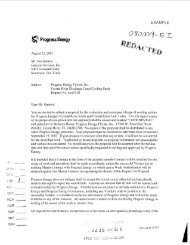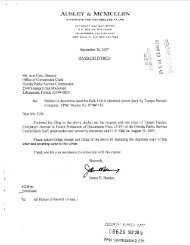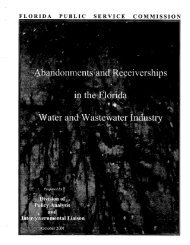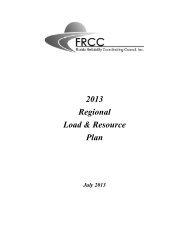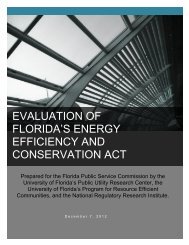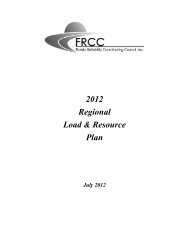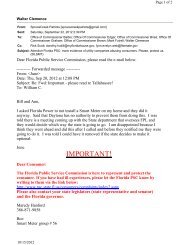Review of 2008 Ten-Year Site Plans - Public Service Commission
Review of 2008 Ten-Year Site Plans - Public Service Commission
Review of 2008 Ten-Year Site Plans - Public Service Commission
You also want an ePaper? Increase the reach of your titles
YUMPU automatically turns print PDFs into web optimized ePapers that Google loves.
As shown in Figure 11 below, between 1980 and 2000, moderate fuel prices, as well as a<br />
balanced planning approach used by Florida’s utilities, resulted in relatively stable average electricity<br />
prices for Florida’s ratepayers with real prices actually declining. Starting in 2001, natural gas prices<br />
began to increase nationwide. The actual cost <strong>of</strong> natural gas for FPL more than doubled between<br />
2002 and 2007, rising from approximately $4.06 per MMBtu in 2002 to $9.70 per MMBtu in 2007.<br />
The increase in natural gas prices, coupled with Florida’s growing dependence on natural gas<br />
generation, reversed the trend <strong>of</strong> stable electricity prices causing an increase in the average electric bill<br />
in recent years, a trend illustrated in Figure 11 below.<br />
$ per 1000 KWh<br />
120<br />
100<br />
80<br />
60<br />
40<br />
20<br />
Figure 11. Average Residential Electric Bill: 1980 to Present<br />
0<br />
1980 1983 1986 1989 1992 1995 1998 2001 2004 2007<br />
Nominal Real<br />
Moreover, in 2005, hurricanes and tropical storms in the Gulf <strong>of</strong> Mexico caused short-term<br />
spikes due to gas supply disruptions. The effects <strong>of</strong> higher, volatile gas prices have been dramatic on<br />
customer bills. Such events illustrate the importance <strong>of</strong> a balanced fuel supply since fuel diversity can<br />
serve as a risk mitigation strategy by providing a dampening effect on fuel price volatility caused by<br />
daily market conditions.<br />
Over the last 20 years, Florida’s utilities have turned to natural gas to satisfy the state’s<br />
growing energy demand. The recent volatility <strong>of</strong> natural gas prices, however, has shown that the<br />
overdependence on a single fuel can lead to an unacceptable risk <strong>of</strong> supply disruptions and rate<br />
increases. Unfortunately, fuel diversity cannot be achieved overnight.<br />
Proposed Generating Units<br />
In addition to meeting projected load, the FRCC has a resource adequacy standard requiring a<br />
15 percent reserve margin, above peak demand, which the utilities must meet. Since the summer <strong>of</strong><br />
2004, the three IOUs in the FRCC region (FPL, PEF, and TECO) have employed a 20 percent reserve<br />
margin criteria. Figure 12 shows the summer peninsular reserve margin, which includes DSM, energy<br />
efficiency, renewable generation, and traditional utility generation. Since the reserve margin exceeds<br />
<strong>Review</strong> <strong>of</strong> <strong>2008</strong> <strong>Ten</strong>-<strong>Year</strong> <strong>Site</strong> <strong>Plans</strong> - 23 -




